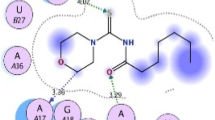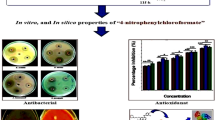Abstract
Individually, hydroxycoumarin and amino pyrimidine derivatives are of significant biological interest owing to their importance in drugs and pharmaceuticals. To access their combined biological impact into one molecule, we designed a novel, one-pot green approach for synthesizing trisubstituted methanes. A series of new heteroaryl-substituted methanes have been synthesized and subjected to in vitro antibacterial and antioxidant evaluation. Tests against clinical isolates of Escherichia coli (gram-negative) and Staphylococcus aureus showed potent activity of the derivatives 4a, 4b, 4d, 4e, 4f, 4l, and 5 against the former, and 4a, 4e, 4j, and 4l against the later one. Further, antioxidant assay for these TRSMs was also studied where 4a, 4b, 4f, 4j, and 4l exhibited the most promising results. These preliminary bioassay evaluations strongly suggest the promise and scope of these molecules in medical science.
Graphical abstract
A one pot methodology for the synthesis of coumarin and uracil tethered trisubstituted methanes has been reported. The synthesized derivatives were further analyzed for their antibacterial and antioxidant properties to explore their medicinal applications. The salient features of this methodology are operational simplicity, short reaction time, good to moderate yields of the products, easy purification method. Biochemical assay of the synthesized TRSMs a reveals their utility in medicinal & pharma industry.










Similar content being viewed by others
References
Toure BB, Hall DG (2009) Natural product synthesis using multicomponent reaction strategies. Chem Rev 109(9):4439–4486
Dondoni A, Massi A (2006) Design and synthesis of new classes of heterocyclic C-glycoconjugate s and carbon-linked sugar and heterocyclic amino acids by asymmetric multicomponent reactions (AMCRs). Acc Chem Res 39(7):451–463
Wessjohann LA, Rivera DG, Vercillo OE (2009) Multiple multicomponent macrocyclizations (MiBs): a strategic development toward macrocycle diversity. Chem Rev 109(2):796–814
Younus HA, Al-Rashida M, Hameed A, Uroos M, Salar U, Rana S, Khan KM (2021) Multicomponent reactions (MCR) in medicinal chemistry: a patent review (2010–2020). Expert Opin Ther Pat 31(3):267–289
Amabilino DB, Ashton PR, Bělohradský M, Raymo FM, Stoddart JF (1995) The self-assembly of branched [n] rotaxanes—the first step towards dendritic rotaxanes. J Chem Soc, Chem Commun 7:751–753
Ashton PR, Ballardini R, Balzani V, Credi A, Dress KR, Ishow E, Kleverlaan CJ, Kocian O, Preece JA, Spencer N, Stoddart JF (2000) A photochemically driven molecular-level abacus. Chem European J 6(19):3558–3574
Liao KY, Hsu CW, Chi Y, Hsu MK, Wu SW, Chang CH, Liu SH, Lee GH, Chou PT, Hu Y, Robertson N (2015) Pt (II) metal complexes tailored with a newly designed spiro-arranged tetradentate ligand; harnessing of charge-transfer phosphorescence and fabrication of sky blue and white OLEDs. Inorg Chem 54(8):4029–4038
Panda G, Parai MK, Das SK, Sinha M, Chaturvedi V, Srivastava AK, Manju YS, Gaikwad AN, Sinha S (2007) Effect of substituents on diarylmethanes for antitubercular activity. Eur J Med Chem 42(3):410–419
Kumar A, Panda G, Siddiqi MI (2007) CoMFA and CoMSIA 3D-QSAR analysis of diaryloxy-methano-phenanthrene derivatives as anti-tubercular agents. J Mol Model 13(1):99–109
Zhou B, Liu DX, Yuan XJ, Li JY, Xu YC, Li J, Li Y, Yue JM (2018) (−)-and (+)-securidanes A and B, natural triarylmethane enantiomers: structure and bioinspired total synthesis. Research. https://doi.org/10.1155/2018/2674182
Sashidhara KV, Kumar A, Kumar M, Srivastava A, Puri A (2010) Synthesis and antihyperlipidemic activity of novel coumarin bisindole derivatives. Bioorg Med Chem Lett 20(22):6504–6507
Srivastava N, Ray S, Singh MM, Dwivedi A, Kumar A (2004) Diaryl naphthyl methanes a novel class of anti-implantation agents. Bioorg Med Chem 12(5):1011–1021
Al-Qawasmeh RA, Lee Y, Cao MY, Gu X, Vassilakos A, Wright JA, Young A (2004) Triaryl methane derivatives as antiproliferative agents. Bioorg Med Chem Lett 14(2):347–350
Hill J, Schnitzer RJ, Hawking F (1963) Experimental chemotherapy. Chemother Malaria Part 2 Antimalar Drugs 1:417–441
Srivastava AK, Sharma R, Mishra R, Balapure AK, Murthy PS, Panda G (2006) Substituted phenanthrenes with basic amino side chains: a new series of anti-breast cancer agents. Bioorg Med Chem 14(5):1497–1505
Tangmouo JG, Meli AL, Komguem J, Kuete V, Ngounou FN, Lontsi D, Beng VP, Choudhary MI, Sondengam BL (2006) Crassiflorone, a new naphthoquinone from Diospyros crassiflora (Hien). Tetrahedron Lett 47(18):3067–3070
Yu D, Suzuki M, Xie L, Morris-Natschke SL, Lee KH (2003) Recent progress in the development of coumarin derivatives as potent anti-HIV agents. Med Res Rev 23(3):322–345
Borges F, Roleira F, Milhazes N, Santana L, Uriarte E (2005) Simple coumarins and analogues in medicinal chemistry: occurrence, synthesis and biological activity. Curr Med Chem 12(8):887–916
Kraus GA, Kim I (2003) A direct synthesis of O-methyl claussequinone. J Org Chem 68(11):4517–4518
Satyanarayana VS, Sreevani P, Sivakumar A, Vijayakumar V (2008) Synthesis and antimicrobial activity of new Schiff bases containing coumarin moiety and their spectral characterization. ARKIVOC 17:221–233
Kanth SR, Reddy GV, Kishore KH, Rao PS, Narsaiah B, Murthy US (2006) Convenient synthesis of novel 4-substitutedamino-5-trifluoromethyl–2, 7-disubstituted pyrido [2, 3-d] pyrimidines and their antibacterial activity. Eur J Med Chem 41(8):1011–1016
Grivsky EM, Lee S, Sigel CW, Duch DS, Nichol CA (1980) Synthesis and antitumor activity of 2, 4-diamino-6-(2, 5-dimethoxybenzyl)-5-methylpyrido [2, 3-d] pyrimidine. J Med Chem 23(3):327–329
Heber D, Heers C, Ravens U (1993) Positive inotropic activity of 5-amino-6-cyano-1, 3-dimethyl-1, 2, 3, 4-tetrahydropyrido [2, 3-d] pyrim idine-2, 4-dione in cardiac muscle from guinea-pig and man. Part 6: compounds with positive inotropic activity. Pharmazie 48(7):537–541
Bennett LR, Blankley CJ, Fleming RW, Smith RD, Tessman DK (1981) Antihypertensive activity of 6-arylpyrido [2, 3-d] pyrimidin-7-amine derivatives. J Med Chem 24(4):382–389
Davoll J, Clarke J, Elslager EF (1972) Antimalarial substances. 26. Folate antagonists. 4. Antimalarial and antimetabolite effects of 2, 4-diamino-6-[(benzyl) amino] pyrido [2, 3-d] pyrimidines. J Med Chem 15(8):837–839
Emmadi NR, Atmakur K, Bingi C, Godumagadda NR, Chityal GK (2014) Regioselective synthesis of 3-benzyl substituted pyrimidino chromen-2-ones and evaluation of anti-microbial and anti-biofilm activities. Bioorg Med Chem Lett 24(2):485–489
Kandhasamy S, Ramanathan G, Muthukumar T, Thyagarajan S, Umamaheshwari N, Santhanakrishnan VP, Sivagnanam UT, Perumal PT (2017) Nanofibrous matrixes with biologically active hydroxybenzophenazine pyrazolone compound for cancer theranostics. Mater Sci Eng, C 74:70–85
Basumatary G, Dhar ED, Das D, Deka RC, Yadav AK, Bez G (2020) Coumarin-based trisubstituted methanes as potent anthelmintic: synthesis, molecular docking and in vitro efficacy. J Chem Sci 132(1):1–12
Lin Y, Shen X, Yuan Q, Yan Y (2013) Microbial biosynthesis of the anticoagulant precursor 4-hydroxycoumarin. Nat Commun 4(1):1–8
Bharti R, Parvin T (2015) Molecular diversity from the L-proline-catalyzed, three-component reactions of 4-hydroxycoumarin, aldehyde, and 3-aminopyrazole or 1, 3-dimethyl-6-aminouracil. Synth Commun 45(12):1442–1450
Bharti R, Parvin T (2015) Diversity oriented synthesis of tri-substituted methane containing aminouracil and hydroxynaphthoquinone/hydroxycoumarin moiety using organocatalysed multicomponent reactions in aqueous medium. RSC Adv 5(82):66833–66839
Basumatary G, Mohanta R, Bez G (2019) l-proline derived secondary aminothiourea organocatalyst for synthesis of coumarin derived trisubstituted methanes: rate enhancement by bifunctional catalyst over cooperative catalysis. Catal Lett 149(10):2776–2786
Verma M, Thakur A, Sharma R, Bharti R (2021) Recent Advancement in the One-Pot Synthesis of the Tri-Substituted Methanes (TRSMs) and Their Biological Applications. Curr Org Synth. https://doi.org/10.2174/1570179418666210910105342
Kumari P, Yadav R, Bharti R, Parvin T (2020) Regioselective synthesis of pyrimidine-fused tetrahydropyridines and pyridines by microwave-assisted one-pot reaction. Mol Divers 24(1):107–117
Kumari P, Bharti R, Parvin T (2019) Synthesis of aminouracil-tethered tri-substituted methanes in water by iodine-catalyzed multicomponent reactions. Mol Divers 23(1):205–213
Panday AK, Mishra R, Jana A, Parvin T, Choudhury LH (2018) Synthesis of pyrimidine fused quinolines by ligand-free copper-catalyzed domino reactions. J Org Chem 83(7):3624–3632
Bharti R, Kumari P, Parvin T, Choudhury LH (2018) Recent advances of aminopyrimidines in multicomponent reactions. Curr Org Chem 22(5):417–445
Jana A, Panday AK, Mishra R, Parvin T, Choudhury LH (2017) Synthesis of thio and selenoethers of cyclic β-hydroxy carbonyls and amino uracils: a metal-free regioselective I2/DMSO mediated reaction. ChemistrySelect 2(29):9420–9424
Bharti R, Kumari P, Parvin T, Choudhury LH (2017) Molecular diversity from the three-component reaction of 2-hydroxy-1, 4-naphthaquinone, aldehydes and 6-aminouracils: a reaction condition dependent MCR. RSC Adv 7(7):3928–3933
Bharti R, Parvin T (2016) Multicomponent synthesis of diverse pyrano-fused benzophenazines using bifunctional thiourea-based organocatalyst in aqueous medium. Mol Diversity 20(4):867–876
Bharti R, Parvin T (2015) One-pot Synthesis of Highly Functionalized Tetrahydropyridines: A Camphoresulfonic Acid Catalyzed Multicomponent Reaction. J Heterocycl Chem 52(6):1806–1811
Parvatkar PT, Parameswaran PS, Tilve SG (2012) Recent developments in the synthesis of five-and six-membered heterocycles using molecular iodine. Chem European J 18(18):5460–5489
Xu X, Jiang R, Zhou X, Liu Y, Ji S, Zhang Y (2009) Cerium ammonium nitrate: an efficient catalyst for carbon–carbon bond formation from ferrocenyl alcohol substrate. Tetrahedron 65(4):877–882
Wang JT, Jia XD, Peng LJ, Wu LM (2011) Cerium (IV) ammonium nitrate (CAN) initiated O-alkylation of oximes with N-vinyl lactams. Chin Chem Lett 22(6):655–658
Han B, Jia XD, Jin XL, Zhou YL, Yang L, Liu ZL, Yu W (2006) A CAN-initiated aza-Diels–Alder reaction for a facile synthesis of 4-amido-N-yl tetrahydroquinolines. Tetrahedron Lett 47(21):3545–3547
Itoh KI, Horiuchi CA (2004) Formation of isoxazole derivatives via nitrile oxide using ammonium cerium nitrate (CAN): a novel one-pot synthesis of 3-acetyl-and 3-benzoylisoxazole derivatives. Tetrahedron 60(7):1671–1681
Fink BE, Mortensen DS, Stauffer SR, Aron ZD, Katzenellenbogen JA (1999) Novel structural templates for estrogen-receptor ligands and prospects for combinatorial synthesis of estrogens. Chem Biol 6(4):205–219
Soare JR, Dinis TC, Cunha AP, Almeida L (1997) Antioxidant activities of some extracts of Thymus zygis. Free Radical Res 26(5):469–478
Bhardwaj P, Thakur MS, Kapoor S, Bhardwaj AK, Sharma A, Saxena S, Chaurasia OP (2019) Phytochemical screening and antioxidant activity study of methanol extract of stems and roots of Codonopsis clematidea from trans-Himalayan region. Pharmacogn J. https://doi.org/10.5530/pj.2019.11.86
Prieto P, Pineda M, Aguilar M (1999) Spectrophotometric quantitation of antioxidant capacity through the formation of a phosphomolybdenum complex: specific application to the determination of vitamin E. Anal Biochem 269(2):337–341
Acknowledgements
We are thankful to Chandigarh University for providing the resources and SAIF, Punjab University, for data analysis.
Author information
Authors and Affiliations
Corresponding author
Additional information
Publisher's Note
Springer Nature remains neutral with regard to jurisdictional claims in published maps and institutional affiliations.
Supplementary Information
Below is the link to the electronic supplementary material.
Rights and permissions
About this article
Cite this article
Verma, M., Thakur, A., Kapil, S. et al. Antibacterial and antioxidant assay of novel heteroaryl-substituted methane derivatives synthesized via ceric ammonium nitrate (CAN) catalyzed one-pot green approach. Mol Divers 27, 889–900 (2023). https://doi.org/10.1007/s11030-022-10461-1
Received:
Accepted:
Published:
Issue Date:
DOI: https://doi.org/10.1007/s11030-022-10461-1




